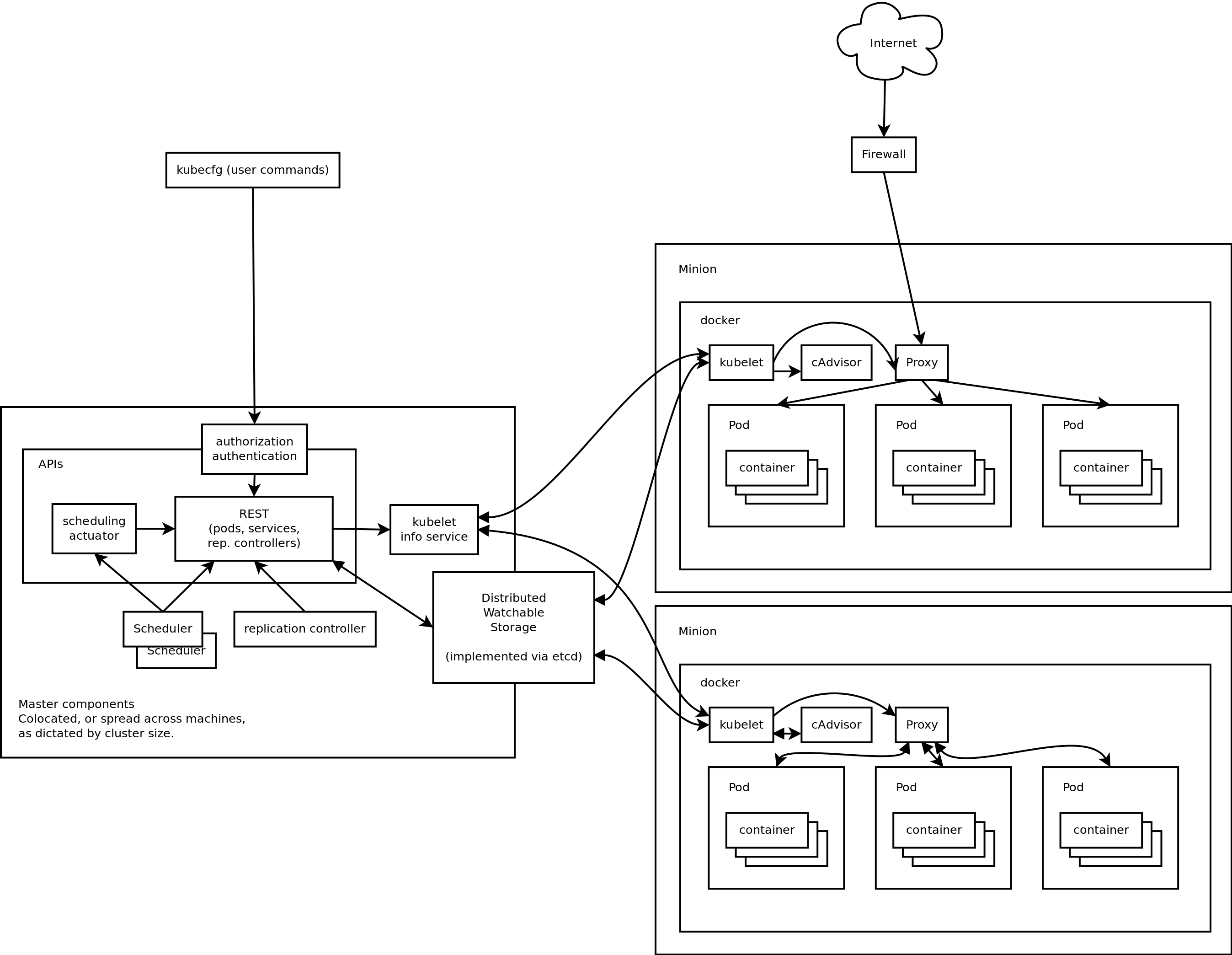Internals
Components
- docker
- etcd
- flannel
- kubelet
- api server
- kube controller manager
- cloud controller manager
- proxy
- scheduler
- cluster DNS

docker
Docker is a software technology providing containers, promoted by the company Docker, Inc. Docker provides an additional layer of abstraction and automation of operating-system-level virtualization on Windows and Linux. Docker uses the resource isolation features of the Linux kernel such as cgroups and kernel namespaces, and a union-capable file system such as OverlayFS and others to allow independent "containers" to run within a single Linux instance, avoiding the overhead of starting and maintaining virtual machines.
All the components of Kubernetes run from within a docker image. etcd and kubelet started from the command line and the rest managed by kubelet.
.png)
etcd
Etcd is a distributed key value store that provides a reliable way to store data across a cluster of machines. It’s open-source and available on GitHub. etcd gracefully handles leader elections during network partitions and will tolerate machine failure, including the leader.
Flannel uses etcd to keep track of it's configuration and managed networks.

flannel
Flannel is a virtual network that gives a subnet to each host for use with container runtimes.

kubelet
The kubelet is the primary “node agent” that runs on each node. The kubelet works in terms of a PodSpec. A PodSpec is a YAML or JSON object that describes a pod. The kubelet takes a set of PodSpecs that are provided through various mechanisms (primarily through the apiserver) and ensures that the containers described in those PodSpecs are running and healthy. The kubelet doesn’t manage containers which were not created by Kubernetes.
Info: http://kamalmarhubi.com/blog/2015/08/27/what-even-is-a-kubelet/
api server
The Kubernetes API server validates and configures data for the api objects which include pods, services, replicationcontrollers, and others. The API Server services REST operations and provides the frontend to the cluster’s shared state through which all other components interact.
Info: http://kamalmarhubi.com/blog/2015/09/06/kubernetes-from-the-ground-up-the-api-server/
kube controller manager
The Kubernetes controller manager is a daemon that embeds the core control loops shipped with Kubernetes. In applications of robotics and automation, a control loop is a non-terminating loop that regulates the state of the system. In Kubernetes, a controller is a control loop that watches the shared state of the cluster through the apiserver and makes changes attempting to move the current state towards the desired state. Examples of controllers that ship with Kubernetes today are the replication controller, endpoints controller, namespace controller, and serviceaccounts controller.
cloud controller manager
Kubernetes version 1.6 contains a new binary called as cloud-controller-manager. cloud-controller-manager is a daemon that embeds cloud-specific control loops in Kubernetes. These cloud-specific control loops were originally in the kube-controller-manager. However, cloud providers move at a different pace and schedule compared to the Kubernetes project, and abstracting the provider-specific code to the cloud-controller-manager binary allows cloud provider vendors to evolve independently from the core Kubernetes code.
proxy
The Kubernetes network proxy runs on each node. This reflects services as defined in the Kubernetes API on each node and can do simple TCP,UDP stream forwarding or round robin TCP,UDP forwarding across a set of backends. Service cluster ips and ports are currently found through Docker-links-compatible environment variables specifying ports opened by the service proxy. There is an optional addon that provides cluster DNS for these cluster IPs. The user must create a service with the apiserver API to configure the proxy.
scheduler
The Kubernetes scheduler is a policy-rich, topology-aware, workload-specific function that significantly impacts availability, performance, and capacity. The scheduler needs to take into account individual and collective resource requirements, quality of service requirements, hardware/software/policy constraints, affinity and anti-affinity specifications, data locality, inter-workload interference, deadlines, and so on. Workload-specific requirements will be exposed through the API as necessary.
Info: http://kamalmarhubi.com/blog/2015/11/17/kubernetes-from-the-ground-up-the-scheduler/
cluster DNS
As of Kubernetes 1.3, DNS is a built-in service launched automatically using the addon manager cluster add-on. Kubernetes DNS schedules a DNS Pod and Service on the cluster, and configures the kubelets to tell individual containers to use the DNS Service’s IP to resolve DNS names.
Every Service defined in the cluster (including the DNS server itself) is assigned a DNS name. By default, a client Pod’s DNS search list will include the Pod’s own namespace and the cluster’s default domain. This is best illustrated by example: Assume a Service named foo in the Kubernetes namespace bar. A Pod running in namespace bar can look up this service by simply doing a DNS query for foo. A Pod running in namespace quux can look up this service by doing a DNS query for foo.bar.

